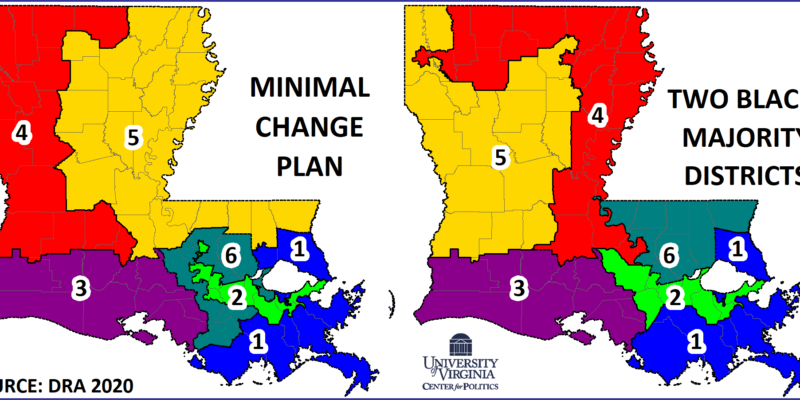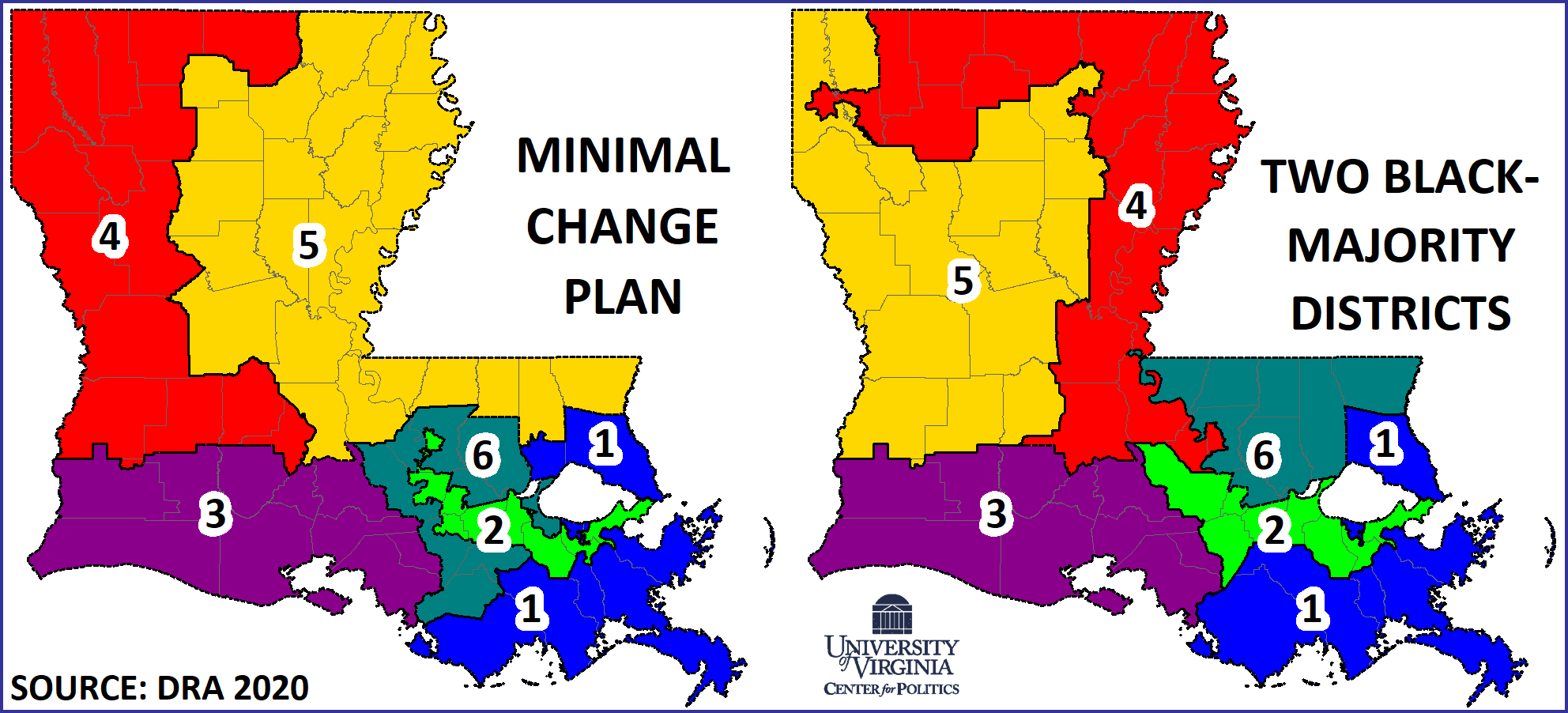We’re hearing there won’t be a redistricting session in the Louisiana legislature until perhaps February of next year, which is a function of how painfully slow the census process has become (and, depending on who you talk to, how much tomfoolery and manipulation is coming out of it).
But when that session begins, it’s going to involve drawing lots of new maps for Louisiana’s political offices. There will need to be new districts fot the Board of Elementary and Secondary Education, for the Public Service Commission, for judicial districts, and for both houses of the state legislature.
But most prominently the redistricting session is going to be about Congress. And that’s where the biggest fight is going to come.
The problem is that John Bel Edwards is Louisiana’s governor. Your default expectation should be that Edwards is going to veto any congressional map which doesn’t eat into the 5-1 Republican-Democrat split of the state’s current congressional delegation. He’s going to demand a second majority-black district, and he and the Legislative Black Caucus are going to try to carve one out of what are currently Louisiana’s 4th and 5th congressional districts.
Democrats wanted an I-20 district very badly 10 years ago when redistricting was last on tap at the Louisiana legislature, but there was never very serious consideration of that. At the time the big issue was the shrinking of the state’s congressional delegation from seven districts down to six, and as Jeff Landry was the newest member of the delegation he was the odd man out; Landry’s district was chopped up and fed into three others and he was forced to run against Charles Boustany in the 2012 cycle. Boustany won, but four years later Landry was the state’s Attorney General and Boustany was out of politics having lost the 2016 Senate race to John Kennedy.
This time, any significant redrawing of the congressional map would pose a direct affront to Louisiana’s current incumbents, none of whom have plans to go anywhere. Edwards and the Black Caucus are essentially then going to have to convince either white Democrats or Republicans to go along with throwing Julia Letlow or Mike Johnson to the wolves in order to create a seat for, for example, Katrina Jackson.
That’s a tough sell. We’ll explain more in a minute.
Here’s what the University of Virginia’s Larry Sabato, who puts out his Crystal Ball newsletter periodically talking about things political and electoral, said about Louisiana in his latest offering, which talks about redistricting in the Southern states…
This cycle, with the state retaining six districts, congressional downsizing won’t generate any redistricting-related drama. Instead, the main source of conflict may come from the governor’s chair: Louisiana is the only state in this group where a Democratic governor might be able to sustain a veto of a GOP-passed map. Though he could well end up signing off on what the legislature comes up with, many Democrats have urged Gov. John Bel Edwards (D-LA) to insist that a second Black-majority seat be drawn. As the state is roughly one-third Black, Democrats argue that two minority-influence seats would better reflect the state’s population. Republicans are just short of a supermajority in the legislature — if Edwards vetoes one of their maps, GOP legislators would need help from a few non-Republicans in the state House to override him. If Edwards and the Republicans can’t agree on a plan, the process will get kicked to the courts, where Edwards (and Democrats) could make the case for more favorable maps.
Map 1 shows a minimal change plan, and then a potential plan with two Black-majority districts.
The image on the left is basically indistinguishable from the current plan. The delegation’s newest member, Republican Rep. Julia Letlow, has the slowest-growing district, so her LA-5 expands its holding in what is known as the state’s Florida Parishes, at the expense of LA-6, which retains its Baton Rouge-area orientation.
After the 2010 census, LA-2, which had long been a New Orleans-area seat, was the least populous district in the country — as many of its low-income neighborhoods bore the brunt of Hurricane Katrina’s flooding, its population was down to fewer than 500,000 residents by the end of the decade. To retain its Black-majority status, LA-2 followed the Mississippi River up to Baton Rouge, where it takes most of the state capital’s minority-heavy precincts. As New Orleans has repopulated since 2010, LA-2 sheds a few western precincts, but sees little change. House Minority Whip Steve Scalise’s LA-1 likewise loses a few peripheral precincts, but its focus is still the wealthy New Orleans suburbs, and it holds some swaths of coastal wetlands.
On the right image, a second Black-majority seat is added, running from Baton Rouge up to Shreveport. Though Louisiana had a district with a similar purpose in the early 1990s, the proposed new map is considerably more compact — in fact, this draft only splits seven parishes, down from the current plan’s 15. LA-2, which is knocked down to 53% Black (the existing district is just over 60% Black), would have still given President Biden 68% in 2020, as white New Orleans liberals often vote with minorities for Democrats. But the new LA-4, which has more of a rural component, would be a racially polarized seat: though it should usually lean Democratic, Biden received 55% in this 54% Black seat. In this scenario, Reps. Letlow and Mike Johnson (R, LA-4) would likely run in the new LA-5, or one may retire.
Though a minimum change map seems the more likely outcome, Republicans would, at worst, retain a 4-2 edge in the Louisiana delegation.
Here are the maps Sabato’s newsletter is talking about…
We’ll just say this – there is absolutely zero chance that Louisiana’s legislature would agree to that second map. The question is whether something like that first map could get a supermajority to withstand a veto from Edwards, and our guess is the odds aren’t bad.
First of all, let’s remember Francis Thompson, who was just censured by the House Democrat delegation for voting to override Edwards’ veto on the girls’ sports bill a week ago. Thompson also just got punished by Edwards for the vote, losing a spot on the Southern Regional Educational Board that he had held since 1980 thanks to the governor’s wrath.
That move has supremely agitated a whole host of legislators. Thompson, who’s been in the legislature since 1976, is a gentlemanly old politician liked by just about everybody up there. And while he’s not particular conservative, his district certainly leans right and he’s voted accordingly fairly often – Thompson’s LABI score for the 2016-19 term was 46 percent, but in previous terms he’d consistently scored above 50, and the last three years he’s been more reliably conservative on economic issues than lots of Republicans. Thompson’s LABI scores the past three years are 59 percent in 2018, 76 percent in 2019 and 95 percent last year. He’s consistently cited by the Louisiana Family Forum as one of the strongest social conservatives in the state, which is why it was a bridge too far to ask him not to override the veto of the girls’ sports bill. Thompson was even prepared to vote yes on an override of the constitutional carry bill.
House District 19 is a Republican district. By voter registration, it’s 40 percent Republican and 37 percent Democrat, and it’s 69 percent white.
There’s been talk in the last few days, especially since Edwards orchestrated the attack on Thompson, that he’s likely to flip to Republican. We don’t know how legitimate that is, but what we can say is that it’s very likely Thompson is going to start operating very much as part of the GOP coalition in the House, and whether he puts an “R” by his name or not he’s going to vote that way.
Assuming the Republicans can count on Joe Stagni’s vote, which is a shaky assumption but he’s usually with his party on governmental matters (not social ones, though), Thompson would give the Republicans 69 votes in the House.
Advertisement
They only need one more to override Edwards’ veto of a redistricting plan.
And here’s where the leverage comes in. Because remember, John Bel Edwards is only relevant in Louisiana politics for two more years, or three more legislative sessions (at most; the 2023 regular session is likely to be a pro-forma affair that features posturing and a budget and not much else). But redistricting defines the political career of every legislator in that building.
Take an Aimee Freeman of House District 98, for example. She’s a white Democrat in Uptown New Orleans, and her district is 69 percent white. Next door in House District 91, Mandie Landry has a 53 percent black district. It’s pretty easy to tell Aimee Freeman “Look, here’s a redistricting plan which preserves the congressional districts more or less as they are and it largely preserves your district as it is. And here’s one which makes a second majority-black congressional district while smacking you up against Landry while creating a majority-black district. And here’s another one in which your district is now majority-black while also making a second majority-black congressional seat. You like this first plan, don’t you? Let’s make sure you vote for that.”
Aimee Freeman knows that the Black Caucus won’t have her back. She knows they would be more than happy to let the Republicans draw her or Mandie Landry out of a seat which they would then gain. So it’s not that hard to get Aimee Freeman’s vote for a redistricting plan both on the front end and on the veto override end. Obviously these are separate votes for a state House map and a congressional map, but if it’s presented as a grand bargain it’ll function as the same plan.
Then there’s Roy Daryl Adams, who is busy groveling to the Republicans now over his regret that he lied to House Speaker Clay Schexnayder on the girls’ sports bill. Adams needs redemption, because as it stands now he’s probably easier to beat in 2023 than any other incumbent in the Louisiana House of Representatives. It’s the easiest thing in the world to play hardball with Roy Daryl Adams to preserve Julia Letlow’s congressional seat, particularly when Letlow is likely to be the congresswoman for most of Adams’ House district.
The point is, there are multiple avenues to get to 70 votes in the House for an override of a congressional map which preserves the delegation largely as is. Even Sabato and his team, who lean fairly left, concede that a second majority-black district is unlikely.
What’s going to be interesting where redistricting is concerned is some of the judicial districts, and particularly whether there’s a second Supreme Court district drawn which is majority black – there is a very good chance that Jeff Hughes will be drawn out of his Supreme Court seat after all of his recent troubles. Whether a few white Democrats in the House are sacrificed to increase Black Caucus representation and spin out an extra Republican district or two will also factor significantly.
But Congress? Who do you think will have more stroke in drawing those districts, the five incumbents in the delegation, one of whom is in line to become the House Majority Leader on Capitol Hill less than a year from the redistricting session, or a lame-duck Democrat governor likely never to win another Louisiana election?
We’re not dismissing the redistricting fight. We’re just saying the deck isn’t stacked in Edwards’ favor.
Advertisement
Advertisement


